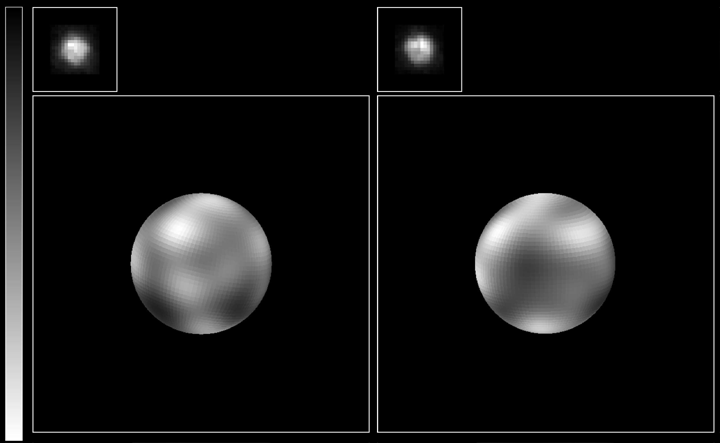It looks like you're using an Ad Blocker.
Please white-list or disable AboveTopSecret.com in your ad-blocking tool.
Thank you.
Some features of ATS will be disabled while you continue to use an ad-blocker.
share:
Jan. 14, 2014: Are we there yet?
One of the fastest spacecraft ever built -- NASA's New Horizons -- is hurtling through the void at nearly one million miles per day. Launched in 2006, it has been in flight longer than some missions last, and it is nearing its destination: Pluto.
“The encounter begins next January,” says Alan Stern, of the Southwest Research Institute and the mission’s principal investigator. “We’re less than a year away.”
Closest approach is scheduled for July 2015 when New Horizons flies only 10,000 km from Pluto, but the spacecraft will be busy long before that date. The first step, in January 2015, is an intensive campaign of photography by the Long Range Reconnaissance Imager or “LORRI.” This will help mission controllers pinpoint Pluto's location, which is uncertain by a few thousand kilometers.
NASA
So finally during the next year we will get better photos of Pluto. New Horizons is fastest satellite ever created and is soon reaching the Pluto system. Pluto has been very unknown for us. Hubble has taken sharpest photos of Pluto, and they look like this:

Picture source
So we know very little about this alien world. We have discovered that it as 5 moons: Charon, Styx, Nix, Kerberos and Hydra. Charon is so big that it could be called double system, since gravitation center is between them. Pluto even could have ring system, and if it has, New Horizons will find it. If New Horizon would be in Earth's orbit, it could see individual buildings.
Thanks for the info! I knew very little about Pluto but maybe well find more information come January!!
I feel sorry for the New Horizons spacecraft it's going to get all the way out there to Pluto & nobody has informed it that Pluto is no longer a
planet anymore...
edit on 15-1-2014 by Blowback because: (no reason given)
With NASA at the helm we will probably get to see only 10% of what's there in a 90% diluted context.
reply to post by Thebel
So if it's traveling 1 million miles per day..
1 million miles per day / 24 hours = 41666 mph
We can build things that fast?? Or is it easier to reach those speeds in space?
Cool thread S&F
So if it's traveling 1 million miles per day..
1 million miles per day / 24 hours = 41666 mph
We can build things that fast?? Or is it easier to reach those speeds in space?
Cool thread S&F
edit on 15-1-2014 by jhn7537 because: (no reason given)
Very cool! I didn't know about this. I can't wait to see the pictures!
Thanks !
Too bad the pictures won't be as good as they would be if it was orbiting earth.
Pluto could have given Mars a run for the "this rock looks like..... Threads.
Thanks !
Too bad the pictures won't be as good as they would be if it was orbiting earth.
Pluto could have given Mars a run for the "this rock looks like..... Threads.
edit on 15-1-2014 by chiefsmom because: afterthought
So I wonder what they're gonna do when they image that ancient outpost that's been sitting there since before modern man came along?
reply to post by jhn7537
Yes and No.
It's called "Gravity Assist":
Source
Yes and No.
It's called "Gravity Assist":
Launched directly into an Earth-and-solar-escape trajectory with an Earth-relative velocity of about 16.26 km/s (58,536 km/h; 36,373 mph) it set the record for the highest velocity of a human-made object from Earth. Using a combination of monopropellant and gravity assist, it flew by the orbit of Mars on 7 April 2006, Jupiter on 28 February 2007, the orbit of Saturn on 8 June 2008; and the orbit of Uranus on 18 March 2011.
Source
reply to post by Thebel
Very cool. Never let it be said that science doesn't have it's
strong points.
SnF
Very cool. Never let it be said that science doesn't have it's
strong points.
SnF
You fell for the processed images and thought they were photos. Those are NOT photos of Pluto taken by Hubble, they are processed images.
Thebel
Hubble has taken sharpest photos of Pluto, and they look like this:
Picture source
The real photos are fuzzy and can be seen here in the fuzzy pixellated dots at the top:
nssdc.gsfc.nasa.gov...
The sharp edges on the bottom processed images were my first clue they aren't photos.
The large lower images are processed versions made from a number of Hubble observations. The smaller images at the top are actual raw images, each pixel is over 150 km across.
This points to all the more reason we need clearer photos of Pluto.
Blowback
I feel sorry for the New Horizons spacecraft it's going to get all the way out there to Pluto & nobody has informed it that Pluto is no longer a planet anymore...edit on 15-1-2014 by Blowback because: (no reason given)
Don't.
New Horizons was always envisioned as a mission to explorer Kuiper Belt Objects. Pluto is one of them. It will explore others after the Pluto flyby.
jhn7537
reply to post by Thebel
So if it's traveling 1 million miles per day..
1 million miles per day / 24 hours = 41666 mph
We can build things that fast??
Yes. But that's not how it got that fast.
But yes, ion propulsion over time or fusion pulse propulsion could get you that fast.
Or is it easier to reach those speeds in space?
Yes. Because of gravity assists from the planets. That's how New Horizon's speed was built up.
As shown here:
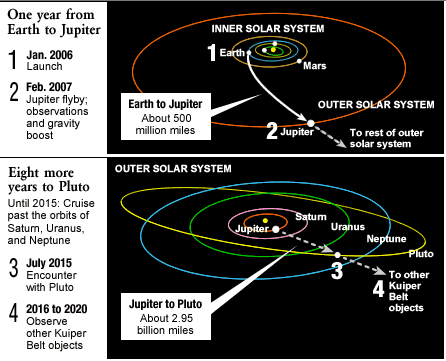
edit on 15-1-2014 by JadeStar because: (no reason given)
The New Horizons used Jupiter as "slingshot". It gained enormous speed increase when it passed Jupiter from 2,3 million kilometers away. Same time
it took pictures of it. Before the gravity assist, New Horizon's speed was 14 000 km/h, but after it was boosted to 84 000 km/h (heliocentric
velocity). Same time the travel time to Pluto was decreased by 3 years. Jupiter is very massive and perfect way to get extra speed.
New Horizons has already proved its worthiness. It took important pictures of Jupiter that were better than previous Galileo mission. "The Little Red Spot" was imaged first time from close. New Horizons tried to find new moons from Jupiter's ring system, but didn't find any. It also photographed Jupiter's moons.
After the gravity assist, New Horizons was set to hibernation mode. Jupiter was its last "stop" before Pluto. Saturn, Uranus and Neptune are elsewhere.
The New Horizons doesn't have any solar panels, as their power would be very weak there. It has Plutonium-238 battery, which gave 250 Watts at launch, and drops approx 5% per year, 200 Watts when it encounters Pluto. It was actually opposed as people feared that if launch was failed, Plutonium would have spread all over the United States (It has 11 kg of Plutonium oxide pellets)
New Horizons has already proved its worthiness. It took important pictures of Jupiter that were better than previous Galileo mission. "The Little Red Spot" was imaged first time from close. New Horizons tried to find new moons from Jupiter's ring system, but didn't find any. It also photographed Jupiter's moons.
After the gravity assist, New Horizons was set to hibernation mode. Jupiter was its last "stop" before Pluto. Saturn, Uranus and Neptune are elsewhere.
The New Horizons doesn't have any solar panels, as their power would be very weak there. It has Plutonium-238 battery, which gave 250 Watts at launch, and drops approx 5% per year, 200 Watts when it encounters Pluto. It was actually opposed as people feared that if launch was failed, Plutonium would have spread all over the United States (It has 11 kg of Plutonium oxide pellets)
reply to post by cprnicus
Exciting stuff.
Mind you, they'll get a shock if it turns out Pluto and Charon are actually a couple of derelict death stars
Those Hubble images seem to show a massive crater in the South that covers almost half of the hemisphere.
Maybe Charon and Pluto collided long ago?
Not long to wait now though.
Exciting stuff.
Mind you, they'll get a shock if it turns out Pluto and Charon are actually a couple of derelict death stars
Those Hubble images seem to show a massive crater in the South that covers almost half of the hemisphere.
Maybe Charon and Pluto collided long ago?
Not long to wait now though.
Because New Horizons, like the Voyager and Pioneer probes before, will leave our star system and venture into interstellar space there is a drive to
put a little bit more about Earth and its inhabitants on it.
Unlike the Pioneers which featured a gold plaque.....
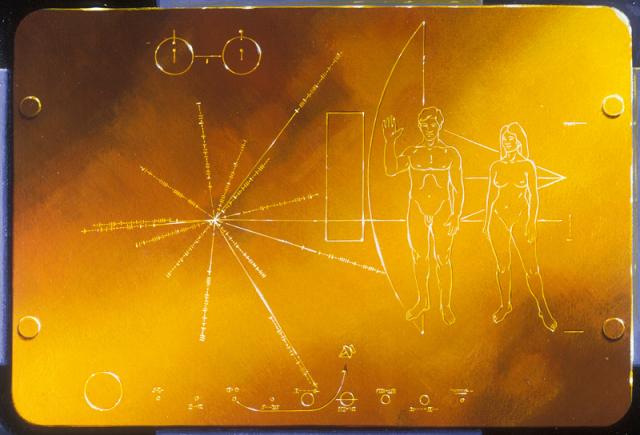
And the Voyagers which featured gold records which were humanity's way of making a statement to the cosmos, containing sounds of nature, samples of music, images of Earth and greetings in 56 languages.
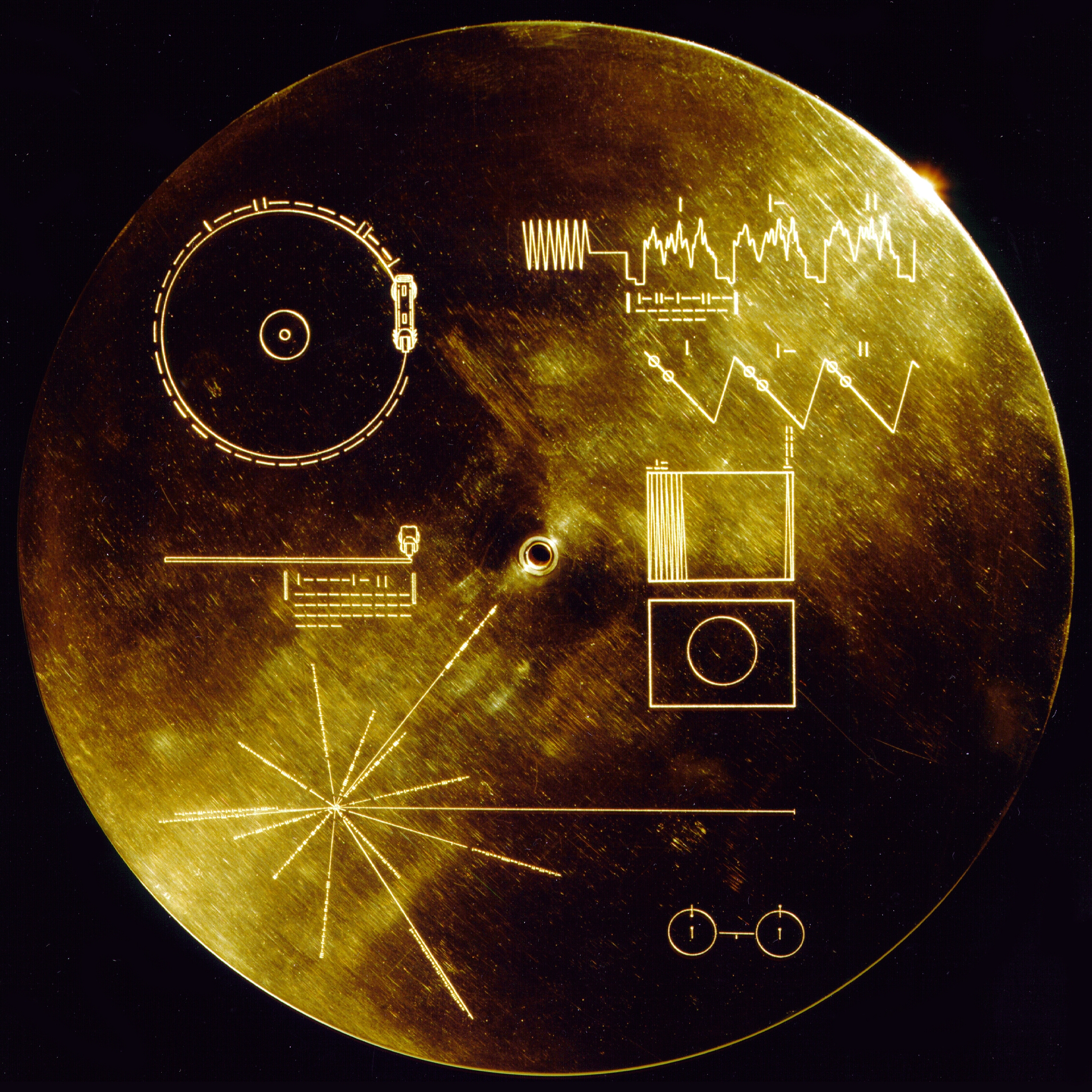
.....New Horizons has no physical object attached to it to tell anyone who made it, where they lived, what they looked like, etc.
That might change soon however and you can be a part of it
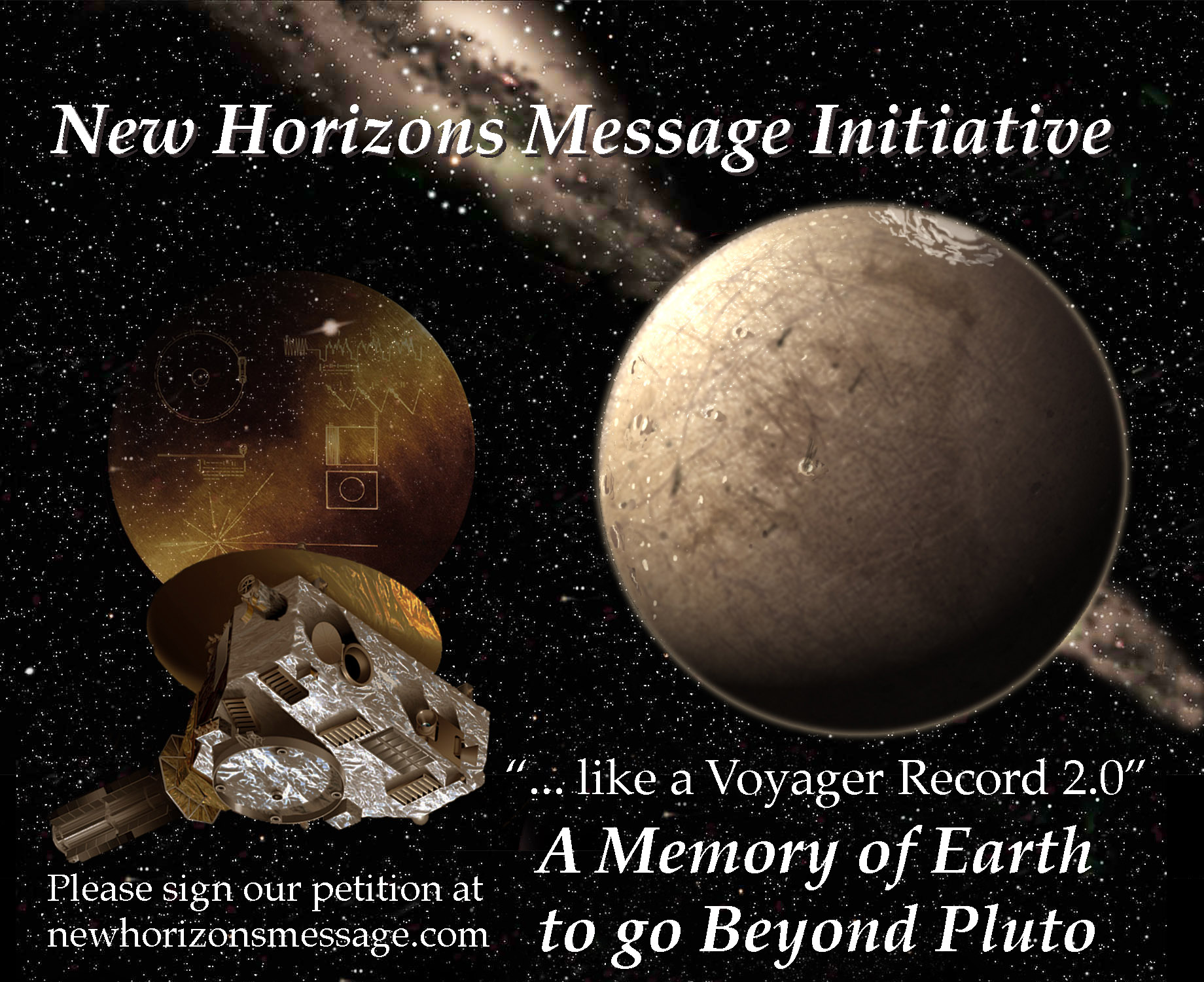
Unlike the Pioneers which featured a gold plaque.....

And the Voyagers which featured gold records which were humanity's way of making a statement to the cosmos, containing sounds of nature, samples of music, images of Earth and greetings in 56 languages.

.....New Horizons has no physical object attached to it to tell anyone who made it, where they lived, what they looked like, etc.
That might change soon however and you can be a part of it

Your Chance to Speak for Earth in a “Voyager Golden Record 2.0”
JOIN US TO CREATE A SELF-PORTRAIT OF HUMANITY TO SEND TO THE STARS ON NASA’S PLUTO MISSION, NEW HORIZONS.
The New Horizons Message Initiative hopes to persuade NASA to upload a crowd-sourced message to the spacecraft’s memory, following a successful Pluto encounter. The form and content of the message are yet to be determined, but will probably consist of pictures and, possibly, sounds. This is a project to create and implement that message.
To me, the most important part of what we are doing is the Message TO Earth aspect. Literally nothing is more important than raising planetary consciousness, a planetary perspective, given the global problems we will face in this century. We can play a worthwhile part in that.
~ Mark Washburn
edit on 15-1-2014 by JadeStar because: (no reason given)
reply to post by Thebel
I'm confused, please...
I thought the gravity of planets (particularly massive ones like Jupiter) pulled things towards them-- like 'capturing' a body into orbit (aka satellite/moon.) Now I hear passing a planet makes something pick up speed?
I understand the 'slingshot' concept, but that involves zooming around a planet. The pic does not seem to show the craft looping around any planets on its way to Pluto.
'splain?
I'm confused, please...
I thought the gravity of planets (particularly massive ones like Jupiter) pulled things towards them-- like 'capturing' a body into orbit (aka satellite/moon.) Now I hear passing a planet makes something pick up speed?
I understand the 'slingshot' concept, but that involves zooming around a planet. The pic does not seem to show the craft looping around any planets on its way to Pluto.
'splain?
new_here
reply to post by Thebel
I'm confused, please...
I thought the gravity of planets (particularly massive ones like Jupiter) pulled things towards them-- like 'capturing' a body into orbit (aka satellite/moon.)
Objects can be captured or flung away at higher velocities. It's orbital mechanics. A planet's gravity is a force and depending on how one approaches that force it can be used to speed up or slow down a craft or other body, depending on the speed of the object and angle of approach.
Now I hear passing a planet makes something pick up speed?
I understand the 'slingshot' concept, but that involves zooming around a planet. The pic does not seem to show the craft looping around any planets on its way to Pluto.
'splain?
The pic didn't zoom in on Jupiter enough to really see it.
Bill Nye will explain it to you.
While he is talking about the Juno probe's flyby of Earth to gain speed on its trip to Jupiter, New Horizons executed a similar maneuver to gain speed to get to Pluto faster than it otherwise would have.
new_here
reply to post by Thebel
I'm confused, please...
I thought the gravity of planets (particularly massive ones like Jupiter) pulled things towards them-- like 'capturing' a body into orbit (aka satellite/moon.) Now I hear passing a planet makes something pick up speed?
I understand the 'slingshot' concept, but that involves zooming around a planet. The pic does not seem to show the craft looping around any planets on its way to Pluto.
'splain?
A gravity assist flyby does not only use a planet's gravity to speed up the passing spacecraft, but also uses that planet's motion around the sun to speed up the spacecraft.
First, let's consider what a gravity assist flyby (of Jupiter, for example) looks like relative to the planet being flown-by (as if the planet was sitting still):
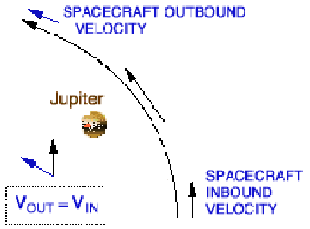
As the above diagram shows, the outbound velocity (VOUT) of the spacecraft would be equal to the inbound velocity (VIN) (i.e., the spacecraft would NOT have gained any net additional velocity after the encounter) because any velocity gained as the spacecraft was being pulled in by the planet's gravity on the spacecraft's inbound path would be lost as the planet tried to pull the spacecraft back during the spacecraft's outbound path...
...thus the net effect would be to cancel out any gain in velocity. The spacecraft would not speed up.
HOWEVER, a planet moves. It moves around the Sun. As shown in the image below, as the inbound spacecraft is partially captured by the gravity of the planet, the momentum of the planet's motion around the sun is added to velocity of the partially captured spacecraft. After the spacecraft completes the flyby, VOUT of the spacecraft now has the additional component that was added by the motion of the planet, thus it would be greater than VIN.
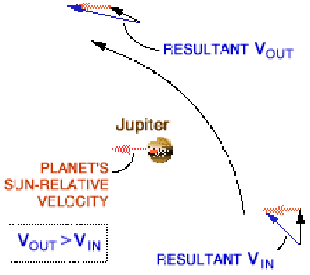
Here is an excerpt from an artical named A Gravity Assist Primer, which is the source for the images above:
The planet's own motion is a key. A gravity assist with Jupiter involves not a stationary planet as considered above, but a planet with enormous angular momentum as it revolves around the Sun. In the diagram at right, Jupiter's motion along its solar orbit has been illustrated with a vector colored red (simplified, of course: Jupiter revolves along an arc, not a straight line. Imagine the Sun situated below the bottom of the diagram). The spacecraft acquires this Sun-relative vector, or a significant portion of it, during its interaction with Jupiter.
You can see how the red vector is added to VIN and VOUT. The resulting vector shows how the spacecraft's velocity, relative to the Sun, takes on a nice boost from Jupiter. Notice how rotation of the vector from VIN and VOUT (the bending of the spacecraft's path by the planet's gravity) helps increase the result. This trajectory bending is the other key.
edit on 1/16/2014 by Soylent Green Is People because: (no reason given)
It's also worth pointing out that the planet itself loses orbital momentum during a gravity assist manouevre. This is where the spacecraft gets what
appears to be "free energy". However, the planet is so massive when compared to the tiny spacecraft, that the effect on the planet's orbit is
essentially negligible. After all, far more massive objects (comets) are regularly subject to gravitational encounters of this kind.
edit on
17-1-2014 by Mogget because: (no reason given)
new topics
-
Man Stabbed or Cardiac arrest on Westminster Bridge, London, UK
Mainstream News: 44 minutes ago -
A fix for the Trans players in sports
Social Issues and Civil Unrest: 2 hours ago -
Petition Calling for General Election at 564,016 and rising Fast
Political Issues: 5 hours ago -
Rep. Alexandria O. Cortez Says Forcing People to Use The Correct Bathroom is Dangerous.
US Political Madness: 11 hours ago
top topics
-
Petition Calling for General Election at 564,016 and rising Fast
Political Issues: 5 hours ago, 11 flags -
France gives Ukraine license to fire long-range missiles at Russia
World War Three: 16 hours ago, 9 flags -
Rep. Alexandria O. Cortez Says Forcing People to Use The Correct Bathroom is Dangerous.
US Political Madness: 11 hours ago, 7 flags -
Ok this is some BS now WTH
Rant: 14 hours ago, 5 flags -
A fix for the Trans players in sports
Social Issues and Civil Unrest: 2 hours ago, 5 flags -
Cooperation zones
World War Three: 13 hours ago, 4 flags -
Man Stabbed or Cardiac arrest on Westminster Bridge, London, UK
Mainstream News: 44 minutes ago, 0 flags
active topics
-
Cooperation zones
World War Three • 16 • : KnowItAllKnowNothin -
Man Stabbed or Cardiac arrest on Westminster Bridge, London, UK
Mainstream News • 1 • : theatreboy -
France gives Ukraine license to fire long-range missiles at Russia
World War Three • 28 • : Imhere -
Results of the use of the Oreshnik missile system in Dnepropetrovsk
World War Three • 185 • : bastion -
Petition Calling for General Election at 564,016 and rising Fast
Political Issues • 30 • : Cymru -
International Criminal Court Issues Arrest Warrant For Netanyahu
Mainstream News • 46 • : JJproductions -
-@TH3WH17ERABB17- -Q- ---TIME TO SHOW THE WORLD--- -Part- --44--
Dissecting Disinformation • 3367 • : Thoughtful3 -
Rep. Alexandria O. Cortez Says Forcing People to Use The Correct Bathroom is Dangerous.
US Political Madness • 28 • : WeMustCare -
Ok this is some BS now WTH
Rant • 10 • : awhispersecho -
A fix for the Trans players in sports
Social Issues and Civil Unrest • 9 • : Xtrozero

